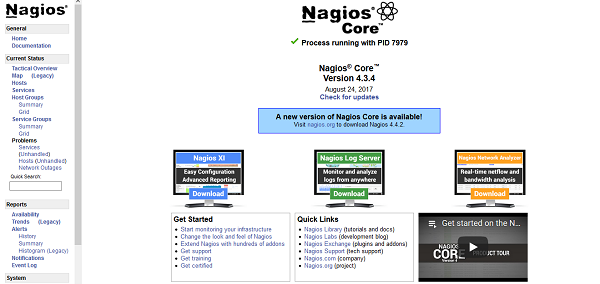By Arslan Ud Din Shafiq, Alibaba Cloud Tech Share Author. Tech Share is Alibaba Cloud's incentive program to encourage the sharing of technical knowledge and best practices within the cloud community.
Nagios is an open source network monitoring software which was released under the GPL license. With more than 1 million users worldwide, it has an active community that provides free support and hundreds of add-ons developed by this community.
In this tutorial, we will be installing and setting up Nagios on an Alibaba Cloud Elastic Compute Service (ECS) with Ubuntu 16.04 installed.
Before proceeding with installation of any kind of package, use the following command to update your Ubuntu system. To execute this command, remember to login from non-root user with sudo privileges.
# sudo apt update && sudo apt upgradeYou will need to install unzip which will be used to unzip the compressed zip folder.
# sudo apt-get install unzip -yYou will need to install libssl-dev on your server.
# sudo apt-get install libssl-devInstall build-essential with the command.
# sudo apt-get install build-essentialTo install and configure libgd2-xpm-dev, execute the command.
# sudo apt-get install libgd2-xpm-devYou will need to install openssl on your server. To install openssl execute the command.
# sudo apt-get install opensslNagios requires installation of PHP 5.3 or newer version of PHP. In this tutorial, you will install PHP 7.2. To install PHP 7.2, execute the following steps.
In the first step, you will need to install python software properties and software properties common. To do so, execute the command below.
# sudo apt-get install software-properties-common python-software-properties You will need to add repository for newer versions of PHP. To do so, execute the commands below.
# sudo add-apt-repository ppa:ondrej/phpUpdate the system to refresh the available repositories. To do so, execute the command for updating Ubuntu system.
# sudo apt updateInstall PHP 7.2. To install PHP 7.2, execute the following command.
# sudo apt install -y php7.2Nagios requires the following PHP extensions:
To install the above extensions of PHP, execute the following command.
# sudo apt install -y php7.2-mysql php7.2-curl php7.2-mbstring libapache2-mod-phpWhen you have done installation of the above extensions, apache2 will be installed automatically.
You can execute the following command to check installed PHP version.
# php --versionTo install Nagios, you will need to follow the steps below.
In the first step, you will create a user group and add a user.
# sudo adduser nagios
# sudo groupadd nagcmdAdd user to nagcmd group.
# sudo adduser nagios nagcmdDownload Nagios by executing the command below.
# curl -L -O https://assets.nagios.com/downloads/nagioscore/releases/nagios-4.3.4.tar.gzIn the second step, you will need to extract files from archived folder by using the command below.
# tar zxf nagios-4.3.4.tar.gzIn the third step, rename the extracted folder.
# mv nagios-4.3.4 nagiosRemove the downloaded archived directory.
# sudo rm nagios-4.3.4.tar.gzNavigate to nagios using the command below.
# cd nagiosBefore building Nagios, you will need to run configure where you will specify username and group you want Nagios to use.
# ./configure --with-nagios-group=nagios --with-command-group=nagcmdExecute the following command to compile Nagios.
# make allExecute the following commands to install Nagios, default configuration and init scripts.
# sudo make install
# sudo make install-commandmode
# sudo make install-init
# sudo make install-configNagios monitors remote hosts using Nagios Remote Plugin Extractor. To install it, follow the steps below.
Navigate to home directory.
# cd ~Download archived folder by using the command below.
# curl -L -O https://github.com/NagiosEnterprises/nrpe/releases/download/nrpe-3.2.1/nrpe-3.2.1.tar.gzExtract archived directory using the command below.
# tar zxf nrpe-*.tar.gzNavigate to nrpe-* extracted directory.
# cd nrpe-*Execute the following commands to configure, compile and install nrpe.
# ./configure
# make check_nrpe
# sudo make install-pluginYou will need to use Apache for serving web interface of Nagios. Execute the following command to copy apache configurations for Nagios to sites-available directory.
# sudo /usr/bin/install -c -m 644 sample-config/httpd.conf /etc/apache2/sites-available/nagios.confTo entertain external commands via web interface to Nagios, you will need to add www-data user to nagcmd group.
# sudo usermod -G nagcmd www-dataOpen Nagio configuration file using command below.
# sudo nano /usr/local/nagios/etc/nagios.cfgFind the line shown below and remove # to uncomment it and then save the file.

You will need to create a directory to store configuration file for each server that you will monitor by executing the command below.
# sudo mkdir /usr/local/nagios/etc/serversExecute the following command to open contacts configuration file and replace email with your own email.
# sudo nano /usr/local/nagios/etc/objects/contacts.cfgOpen the file by executing command below.
# sudo nano /usr/local/nagios/etc/objects/commands.cfgAdd the following text to the end of opened file and save it.
define command{
command_name check_nrpe
command_line $USER1$/check_nrpe -H $HOSTADDRESS$ -c $ARG1$
}You will need to enable rewrite mod. You can do so by editing configuration file in apache2 directory or you can simply execute the command below.
# sudo a2enmod rewriteYou will need to enable cgi mod. You can do so by editing configuration file in apache2 directory or you can simply execute the command below.
# sudo a2enmod cgiTo set the password for accesssing admin panel using username nagiosadmin execute the following command.
# sudo htpasswd -c /usr/local/nagios/etc/htpasswd.users nagiosadminExecute the command below to disable default site.
# sudo a2dissite 000-default.confYou will need to enable the virtual host for Nagios. To do so, execute the command below.
# sudo a2ensite nagiosYou will have to restart apache server to apply the changes and load the settings by executing command below.
# sudo service apache2 restartCreate a system service for Nagios. Execute the following command to open a file for setting up Nagios service.
# sudo nano /etc/systemd/system/nagios.serviceCopy and paste the following text in opened file.
[Unit]
Description=Nagios
BindTo=network.target
[Install]
WantedBy=multi-user.target
[Service]
Type=simple
User=nagios
Group=nagios
ExecStart=/usr/local/nagios/bin/nagios /usr/local/nagios/etc/nagios.cfgExecute the following command to start Nagios service.
# sudo systemctl start NagiosYou can access your Nagios server via IP address or domain name http://your _domain.tld/nagios
After entering username and password for admin, you will be redirected to Nagios dashboard.

Congratulations! You have successfully installed and configured Nagios server monitoring.

2,598 posts | 769 followers
FollowAlibaba Clouder - February 26, 2018
Alibaba Clouder - September 30, 2018
Alibaba Clouder - June 13, 2019
Hiteshjethva - December 12, 2019
Alibaba Cloud Native Community - December 13, 2023
Alibaba Clouder - September 5, 2018

2,598 posts | 769 followers
Follow ECS(Elastic Compute Service)
ECS(Elastic Compute Service)
Elastic and secure virtual cloud servers to cater all your cloud hosting needs.
Learn More CloudMonitor
CloudMonitor
Automate performance monitoring of all your web resources and applications in real-time
Learn MoreLearn More
More Posts by Alibaba Clouder